2022 NISSAN NV200 trailer
[x] Cancel search: trailerPage 118 of 300
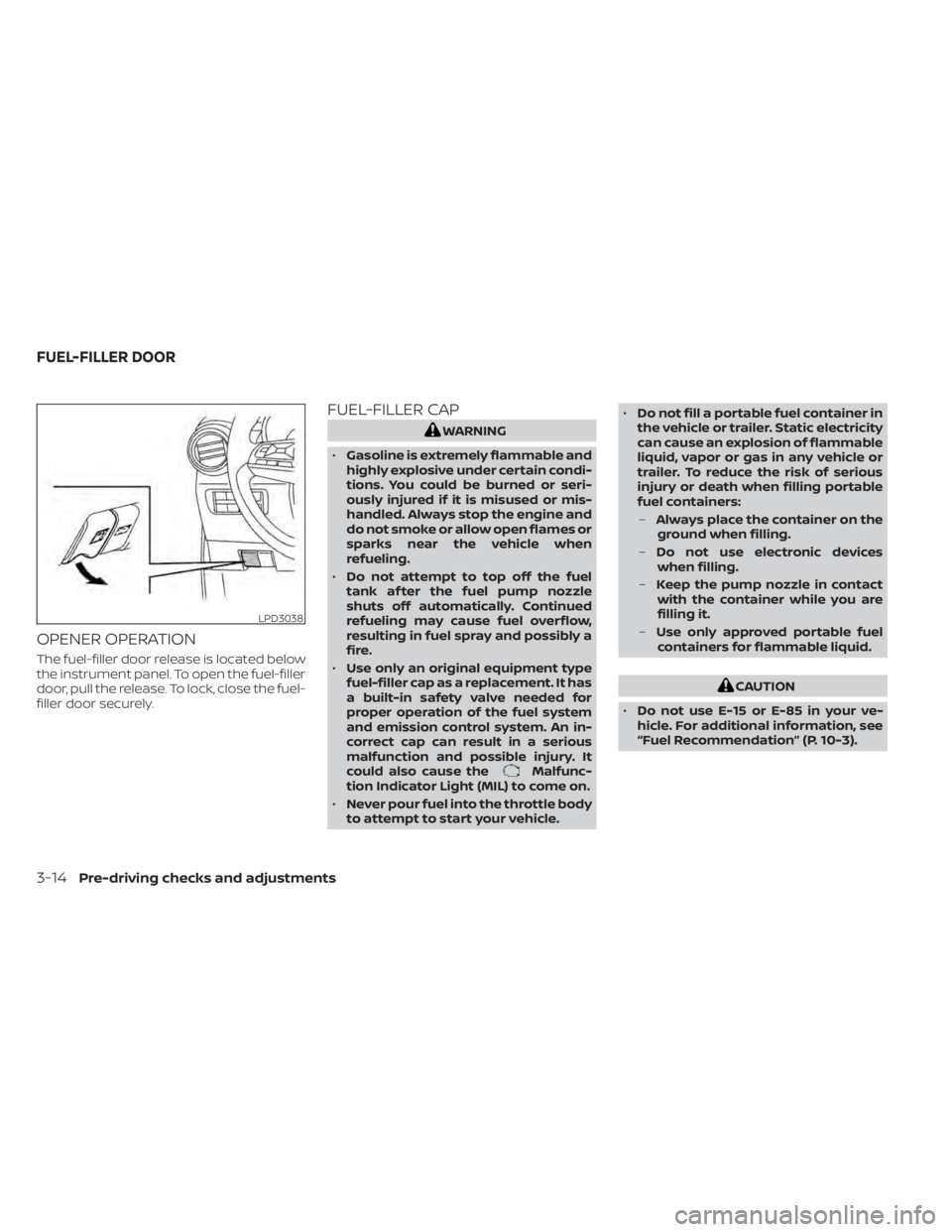
OPENER OPERATION
The fuel-filler door release is located below
the instrument panel. To open the fuel-filler
door, pull the release. To lock, close the fuel-
filler door securely.
FUEL-FILLER CAP
Malfunc-
tion Indicator Light (MIL) to come on.
• Never pour fuel into the throttle body
to attempt to start your vehicle. •
Do not fill a portable fuel container in
the vehicle or trailer. Static electricity
can cause an explosion of flammable
liquid, vapor or gas in any vehicle or
trailer. To reduce the risk of serious
injury or death when filling portable
fuel containers:
– Always place the container on the
ground when filling.
– Do not use electronic devices
when filling.
– Keep the pump nozzle in contact
with the container while you are
filling it.
– Use only approved portable fuel
containers for flammable liquid.
CAUTION
• Do not use E-15 or E-85 in your ve-
hicle. For additional information, see
“Fuel Recommendation” (P. 10-3).
Page 153 of 300
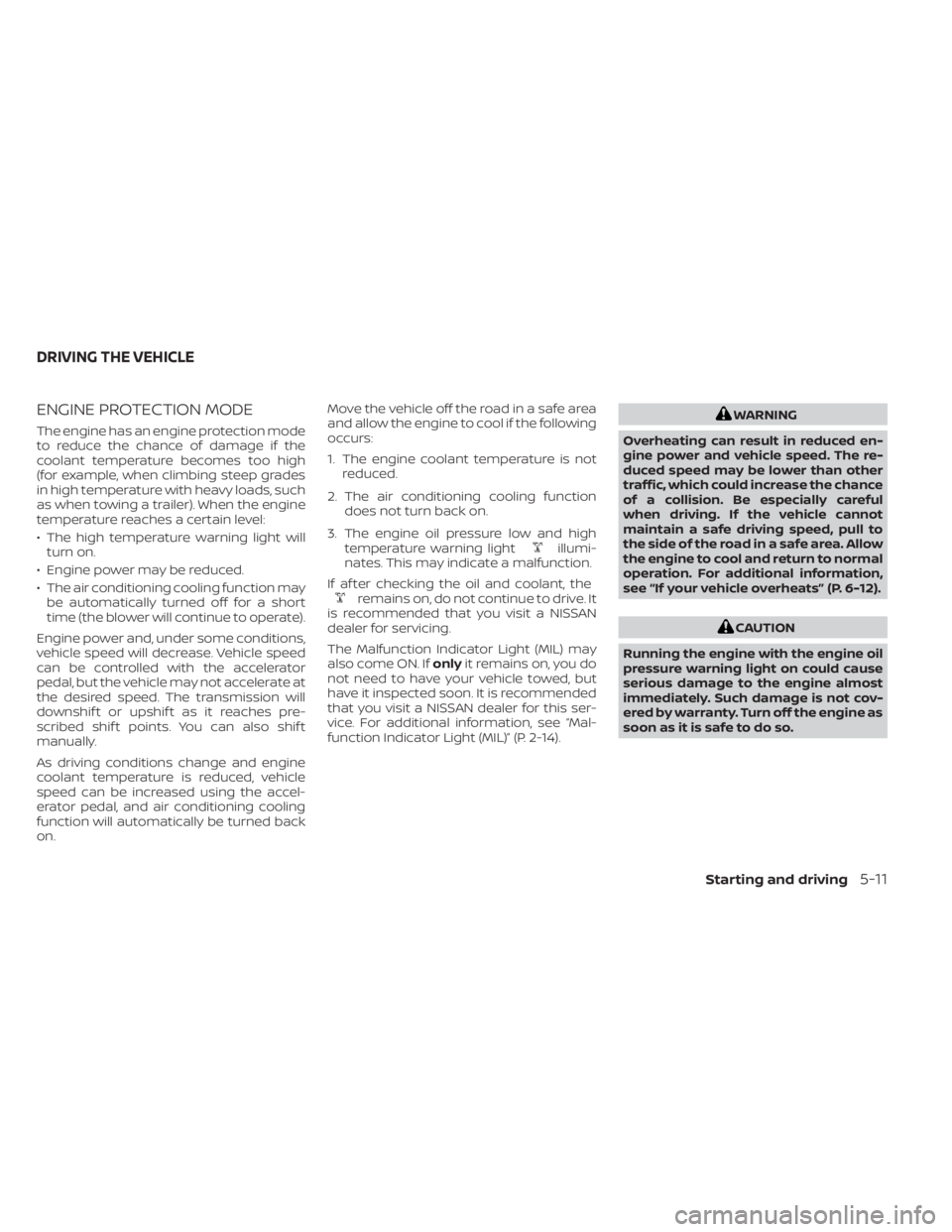
ENGINE PROTECTION MODE
The engine has an engine protection mode
to reduce the chance of damage if the
coolant temperature becomes too high
(for example, when climbing steep grades
in high temperature with heavy loads, such
as when towing a trailer). When the engine
temperature reaches a certain level:
• The high temperature warning light willturn on.
• Engine power may be reduced.
• The air conditioning cooling function may be automatically turned off for a short
time (the blower will continue to operate).
Engine power and, under some conditions,
vehicle speed will decrease. Vehicle speed
can be controlled with the accelerator
pedal, but the vehicle may not accelerate at
the desired speed. The transmission will
downshif t or upshif t as it reaches pre-
scribed shif t points. You can also shif t
manually.
As driving conditions change and engine
coolant temperature is reduced, vehicle
speed can be increased using the accel-
erator pedal, and air conditioning cooling
function will automatically be turned back
on. Move the vehicle off the road in a safe area
and allow the engine to cool if the following
occurs:
1. The engine coolant temperature is not
reduced.
2. The air conditioning cooling function does not turn back on.
3. The engine oil pressure low and high temperature warning light
illumi-
nates. This may indicate a malfunction.
If af ter checking the oil and coolant, the
remains on, do not continue to drive. It
is recommended that you visit a NISSAN
dealer for servicing.
The Malfunction Indicator Light (MIL) may
also come ON. If onlyit remains on, you do
not need to have your vehicle towed, but
have it inspected soon. It is recommended
that you visit a NISSAN dealer for this ser-
vice. For additional information, see “Mal-
function Indicator Light (MIL)” (P. 2-14).
CAUTION
Running the engine with the engine oil
pressure warning light on could cause
serious damage to the engine almost
immediately. Such damage is not cov-
ered by warranty. Turn off the engine as
soon as it is safe to do so.
DRIVING THE VEHICLE
Starting and driving5-11
Page 158 of 300
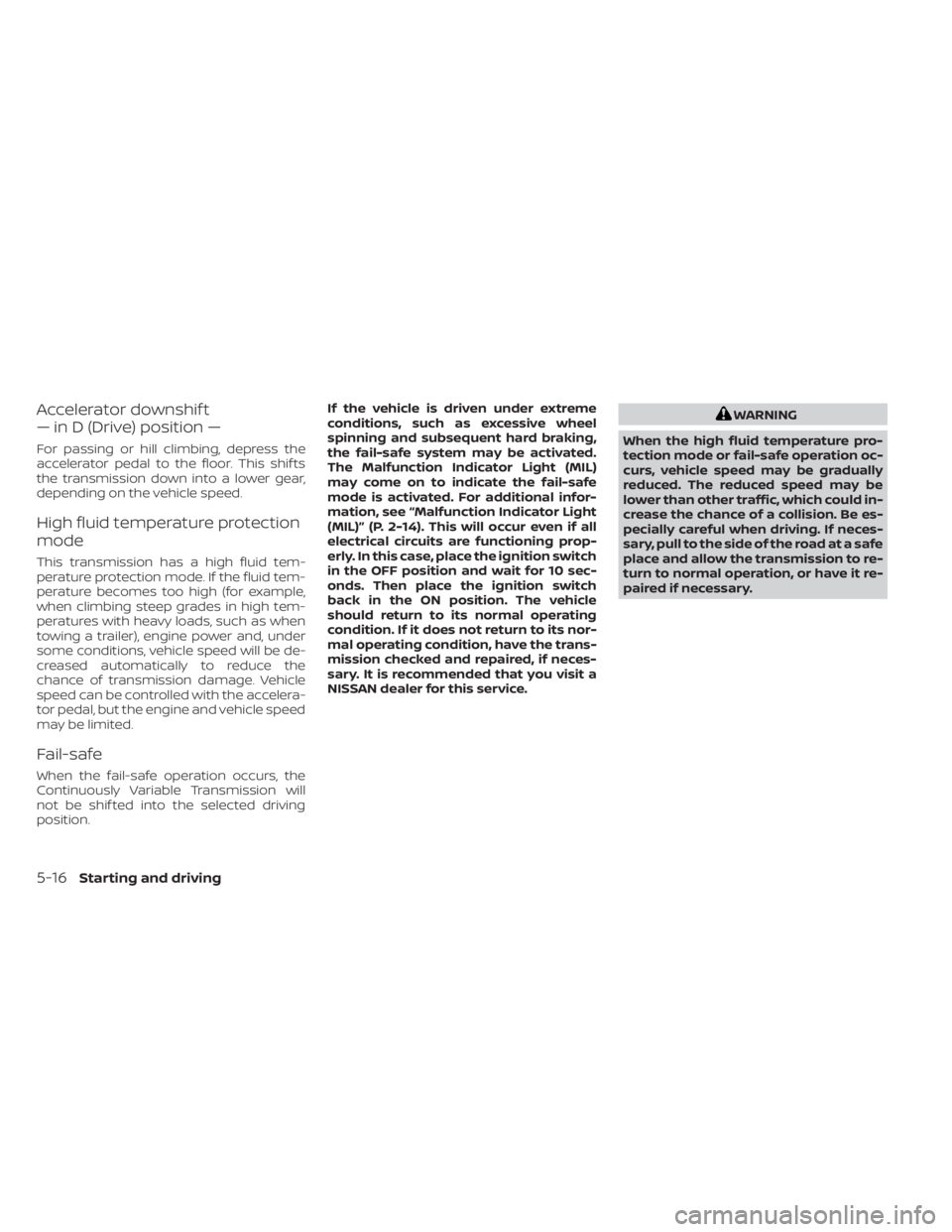
Accelerator downshif t
— in D (Drive) position —
For passing or hill climbing, depress the
accelerator pedal to the floor. This shif ts
the transmission down into a lower gear,
depending on the vehicle speed.
High fluid temperature protection
mode
This transmission has a high fluid tem-
perature protection mode. If the fluid tem-
perature becomes too high (for example,
when climbing steep grades in high tem-
peratures with heavy loads, such as when
towing a trailer), engine power and, under
some conditions, vehicle speed will be de-
creased automatically to reduce the
chance of transmission damage. Vehicle
speed can be controlled with the accelera-
tor pedal, but the engine and vehicle speed
may be limited.
Fail-safe
When the fail-safe operation occurs, the
Continuously Variable Transmission will
not be shif ted into the selected driving
position.If the vehicle is driven under extreme
conditions, such as excessive wheel
spinning and subsequent hard braking,
the fail-safe system may be activated.
The Malfunction Indicator Light (MIL)
may come on to indicate the fail-safe
mode is activated. For additional infor-
mation, see “Malfunction Indicator Light
(MIL)” (P. 2-14). This will occur even if all
electrical circuits are functioning prop-
erly. In this case, place the ignition switch
in the OFF position and wait for 10 sec-
onds. Then place the ignition switch
back in the ON position. The vehicle
should return to its normal operating
condition. If it does not return to its nor-
mal operating condition, have the trans-
mission checked and repaired, if neces-
sary. It is recommended that you visit a
NISSAN dealer for this service.
WARNING
When the high fluid temperature pro-
tection mode or fail-safe operation oc-
curs, vehicle speed may be gradually
reduced. The reduced speed may be
lower than other traffic, which could in-
crease the chance of a collision. Be es-
pecially careful when driving. If neces-
sary, pull to the side of the road at a safe
place and allow the transmission to re-
turn to normal operation, or have it re-
paired if necessary.
5-16Starting and driving
Page 285 of 300
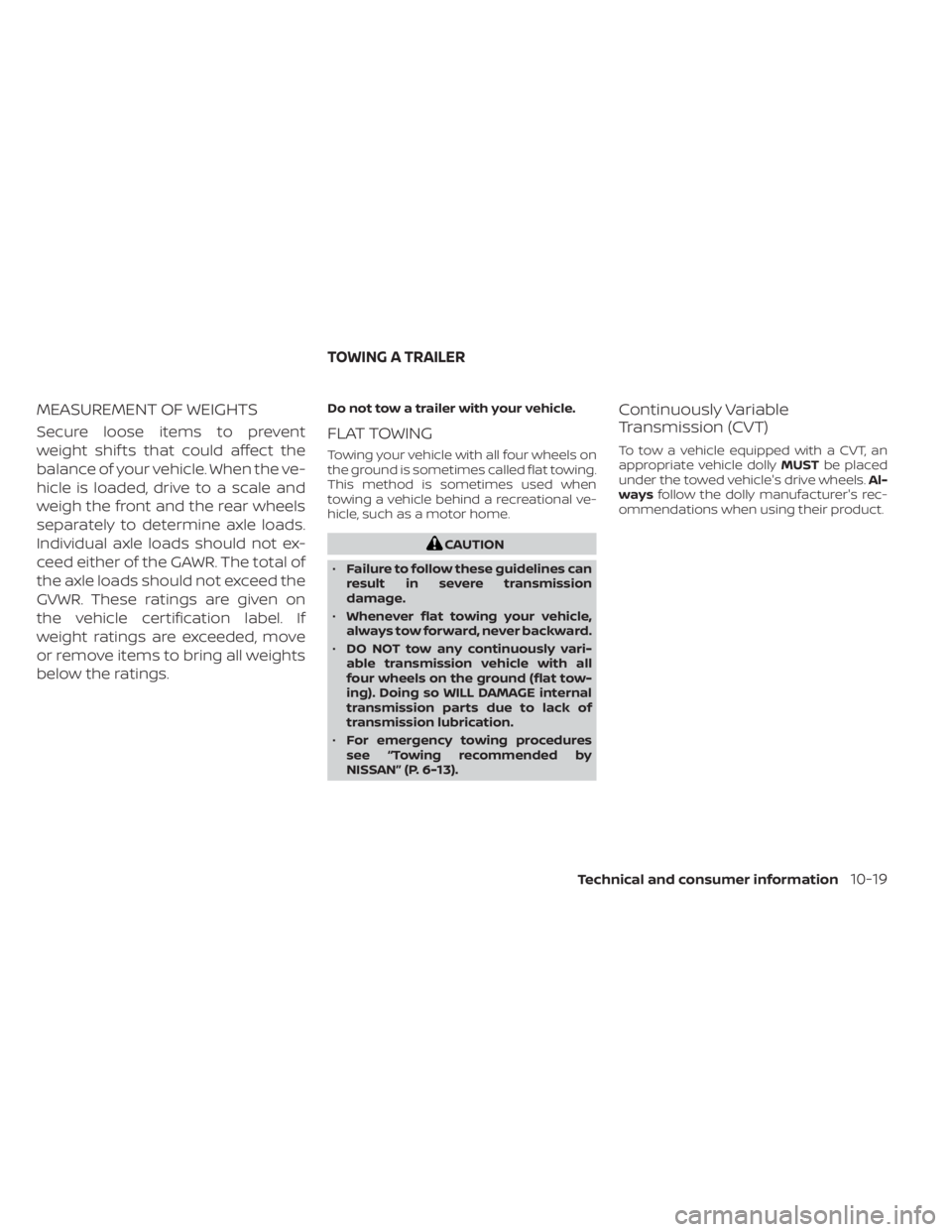
MEASUREMENT OF WEIGHTS
Secure loose items to prevent
weight shif ts that could affect the
balance of your vehicle. When the ve-
hicle is loaded, drive to a scale and
weigh the front and the rear wheels
separately to determine axle loads.
Individual axle loads should not ex-
ceed either of the GAWR. The total of
the axle loads should not exceed the
GVWR. These ratings are given on
the vehicle certification label. If
weight ratings are exceeded, move
or remove items to bring all weights
below the ratings.
Do not tow a trailer with your vehicle.
FLAT TOWING
Towing your vehicle with all four wheels on
the ground is sometimes called flat towing.
This method is sometimes used when
towing a vehicle behind a recreational ve-
hicle, such as a motor home.
Page 296 of 300
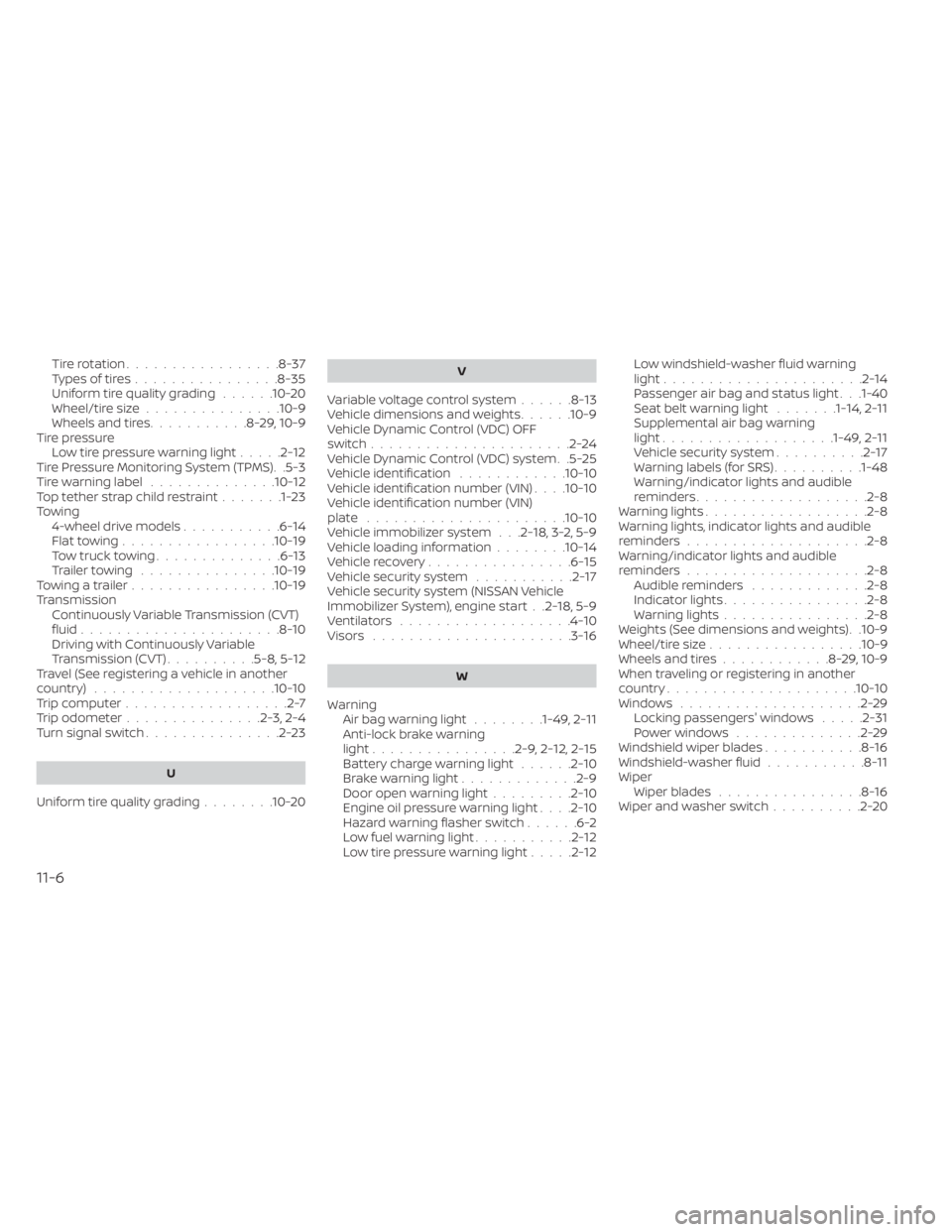
Tire rotation.................8-37Types of tires................8-35Uniform tire quality grading......10-20Wheel/tire size...............10-9Wheels and tires...........8-29,10-9Tire pressure
Low tire pressure warning light.....2-12Tire Pressure Monitoring System (TPMS). .5-3Tire warning label..............10-12Top tether strap child restraint.......1-23Towing4-wheel drive models...........6-14Flat towing................ .10-19Tow truck towing..............6-13Trailer towing...............10-19Towing a trailer................10-19Transmission
Continuously Variable Transmission (CVT)
fluid
......................8-10Driving with Continuously Variable
Transmission (CVT)..........5-8, 5-12Travel (See registering a vehicle in another
country)................... .10-10Trip computer..................2-7Trip odometer...............2-3, 2-4Turn signal switch...............2-23
U
Uniform tire quality grading........10-20
V
Variable voltage control system......8-13Vehicle dimensions and weights......10-9Vehicle Dynamic Control (VDC) OFF
switch......................2-24Vehicle Dynamic Control (VDC) system. .5-25Vehicle identification............10-10Vehicle identification number (VIN). . . .10-10Vehicle identification number (VIN)
plate..................... .10-10Vehicle immobilizer system. . .2-18, 3-2, 5-9Vehicle loading information........10-14Vehicle recovery................6-15Vehicle security system...........2-17Vehicle security system (NISSAN Vehicle
Immobilizer System), engine start. .2-18, 5-9Ventilators...................4-10Visors......................3-16
W
Warning
Air bag warning light........1-49, 2-11Anti-lock brake warning
light................2-9, 2-12, 2-15Battery charge warning light......2-10Brake warning light.............2-9Door open warning light.........2-10Engine oil pressure warning light. . . .2-10Hazard warning flasher switch......6-2Low fuel warning light...........2-12Low tire pressure warning light.....2-12
Low windshield-washer fluid warning
light......................2-14Passenger air bag and status light. . .1-40Seat belt warning light.......1-14,2-11Supplemental air bag warning
light.................. .1-49, 2-11Vehicle security system..........2-17Warning labels (for SRS)..........1-48Warning/indicator lights and audible
reminders...................2-8Warning lights..................2-8Warning lights, indicator lights and audible
reminders................... .2-8Warning/indicator lights and audible
reminders....................2-8Audible reminders.............2-8Indicator lights................2-8Warning lights................2-8Weights (See dimensions and weights). .10-9Wheel/tire size.................10-9Wheels and tires............8-29,10-9When traveling or registering in another
country.................... .10-10Windows....................2-29Locking passengers' windows.....2-31Power windows..............2-29Windshield wiper blades...........8-16Windshield-washer fluid...........8-11Wiper
Wiper blades................8-16Wiper and washer switch..........2-20
11-6